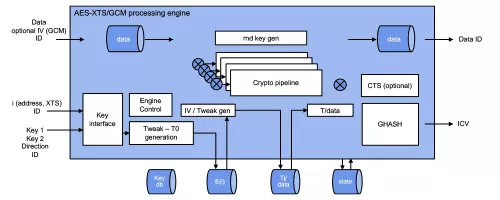The Protocol-IP-338 (EIP-338) is a scalable, high-performance, multi-stream cryptographic engine that offers XTS and GCM modes of operation for the AES algorithms on bulk data. Its flexible data path is suitable to scale from 50 Gbps to 2 Tbps providing a tailored engine with minimal area for your application.
The flexible interface makes it possible to perform processing for many different applications and protocols, including inline memory encryption, inline disk encryption, MACsec, IPsec and OTN security. The multi-stream architecture allows interleaved data processing for many independent data streams simultaneously. Switching between streams can be done every clock cycle without loss of performance. Data is processed without flow control and with fixed latency, dependent on the static configuration selected.
The Protocol-IP-338 data path can be scaled to widths that are multiples of 128 bit to allow a tradeoff between area and performance that best fits the target application. Configuration options include or exclude support for CipherText Stealing (CTS) and AES-GCM.
On-chip SRAM external to the Protocol-IP-338 is used to store the key database as well as various precomputes and state information for each of the streams the engine is processing in interleaved fashion.
How the Protocol-IP-338 High-speed XTS-GCM Multi-stream Engine Works
The Protocol-IP-338 is a data-processing engine and contains input/output data interfaces and interfaces intended for supplying key material that is stored in the engine’s local SRAM.
The Tweak (for XTS) or IV (for GCM) is provided prior to or at the same time as the first data word, together with a reference to the Key slot and the direction of processing in case of GCM. After processing, the Protocol-IP-338 outputs the result data and, in case of GCM mode, authentication tag together with the last output data word.
The external system is responsible for the following items:
Per-block Tweak or IV generation
Key lifetime management, to ensure that the key is refreshed when the current key expires
XTS decrypt key generation in case of an engine configuration without Decrypt Key generator
Reacting to processing errors reported by the Protocol-IP-338
Separate IP cores can be provided to assist with Tweak or Decrypt Key generation.
Before cryptographic processing can start, the Host CPU transfers the key material, together with the AES mode to use, to one of the key slots in the engine. Key material can be shared between multiple streams and many blocks while the key remains available in local SRAM.
ICE-IP-358 High-speed XTS-GCM Multi Stream Inline Cipher Engine, DPA resistant
Overview
Key Features
- Performance and Configuration
- One input word per clock without any backpressure
- Design can switch stream, algorithm, mode, key and/or direction every clock cycle
- For GCM, throughput is solely determined by the data width, data alignment and clock frequency
- For XTS, block processing rate may be limited by the number of configured tweak encryption & CTS cores; a configuration allowing 1 block/clock is possible
- Design achieves up to 2 GHz in 7nm technologies
- FIPS Certification
- Support for XTS-AES, AES-CTR, AES-GMAC, AES-GCM transformations. All modes meet requirements for FIPS certification of the crypto core
- Low Latency with Zero Variation
- Low-latency processing with fixed latency per static pipeline configuration. Pipeline can be statically configured to reduce latency in cases where certain modes or algorithms are not in use
- Cryptographic Processing
- Bi-directional design: direction is selected on a per-key (for XTS) or per-packet (for GCM) basis
- Uni-directional XTS design option for reduced area
- Authenticated encryption & decryption: AES-GCM
- Authentication: AES-GMAC
- Encryption: AES-CTR
- Supported key sizes for AES: 128 and 256 bits
- Tag output
- External 96-bit IV generation that allows supporting various use cases
- Packet Interface
- Push-bus time-sliced interface (no handshake)
- Each data word may belong to a different stream
- Sideband signals for control and processing status
- Configurable bus width, depending on desired throughput in 128-bit units: minimum 128-bit, maximum only limited by area and congestion cost
- Control Plane Interface
- Key loading interface can easily be mapped to a 32-bit wide host interface
- Key set separate from stream state; allows for many parallel streams sharing a limited set of keys to reduce storage requirements
- External Memory Interface
- Set of memory interfaces to buffer data and control information
- All interfaces are for 1R / 1W memory with 2-cycle read latency to allow inserting ECC logic
- ECC uncorrectable status input
- Some memories have per-word chip selection for efficient power usage
- Clocking
- Single-clock synchronous design with a number of switchable clock domains for efficient power usage
Benefits
- Silicon-proven implementation
- Fast and easy to integrate into SoCs
- Flexible layered design
- Complete range of configurations
- World-class technical support
- Driver development kit
- Full virtualization, key separation at application and CPU level
- Embedded cache
- AMBA interfaces
- FIPS-compliant DRBG
Block Diagram

Applications
- SSL
- TLS
- DLTS
- IPsec
- Communication protocols
Technical Specifications
Foundry, Node
Any
Availability
Now
TSMC
Silicon Proven:
7nm
,
16nm
,
28nm
,
40nm
G
Related IPs
- ICE-IP-338 High-speed XTS-GCM Multi Stream Inline Cipher Engine
- In-line Multi-Protocol Cipher Engine
- RSA-ECC Public Key Accelerator Engine, 8K ops/sec, DPA & Fault Injection Resistant
- RSA-ECC Public Key Accelerator Engine DPA Resistant, 8K ops/sec
- RSA-ECC Public Key Accelerator Engine, 2K ops/sec, DPA Resistant
- SNOW3G Stream Cipher Core